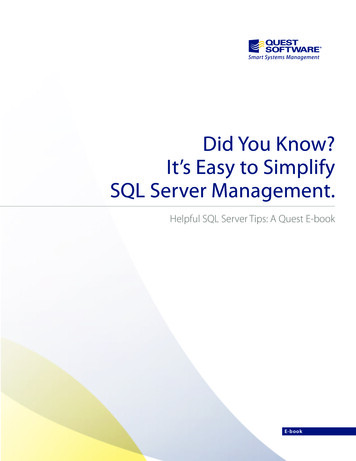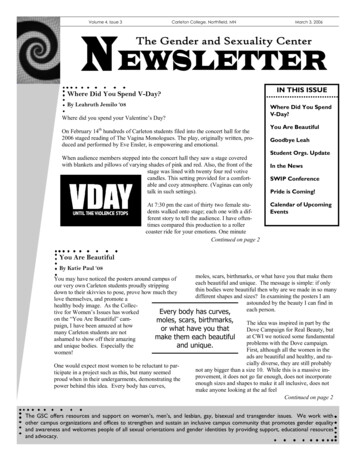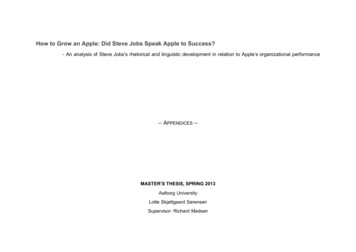
Transcription
Did You Know?It’s Easy to SimplifySQL Server Management.Helpful SQL Server Tips: A Quest E-bookE-book
ContentsQuery Tuning Strategies for Microsoft SQL ServerBy Kevin Klinepage 3Knowing as many tuning tricks and techniques as possible expands your options when tuning for performance. Readthis chapter to discover several basic elements you can use to successfully tune queries. In addition, you’ll be exposedto scenarios where poor performance is common, then learn our recommendations for improvement.Best Practices in Index Maintenance – Fighting the Silent Performance KillersBy Brent Ozarpage 35Index fragmentation is a serious issue in every data center because it can significantly degrade performance. In thischapter, you’ll get an introduction to the problem, find out why native and custom-coded approaches are ineffective,and learn how Quest Capacity Manager for SQL Server delivers a robust and reliable solution.Ten Things DBAs Need to Know About StorageBy Brent Ozarpage 46Sometimes SQL Server database administrators (DBAs) and storage area network (SAN) administrators are at oddswhen discussing storage and capacity. How can they meet half way? The key is communication. This chapter revealsthe top 10 things DBAs should know about storage to help them work effectively with their SAN colleagues.Top Ten Things You Should Know About Optimizing SQL Server PerformanceBy Patrick O’Keeffepage 65Performance optimization on SQL Server is difficult. While a vast array of information exists about how to addressperformance problems in general, there is not much specific information available. In this chapter, learn 10 detailsyou need to know about SQL Server performance. Each detail is a nugget of practical knowledge that can beimmediately applied to your environment.Quest Performance Management Solutions for SQL ServerBy Quest SoftwareThis chapter will show you the value of using Quest’s SQL Server performance management products, includingFoglight Performance Analysis for SQL Server and Spotlight on SQL Server Enterprise. Learn how you can use thissolution set to resolve CPU bottlenecks, I/O bottlenecks, and memory pressure issues, as well as simplifyTempDB troubleshooting.page 94
Query Tuning Strategies forMicrosoft SQL Server Written byKevin Kline, Microsoft MVP since 2004Technical Strategy Manager, Quest SoftwareWHITE PAPER
2009 Quest Software, Inc.ALL RIGHTS RESERVED.This document contains proprietary information protected by copyright. No part of this document may be reproducedor transmitted in any form or by any means, electronic or mechanical, including photocopying and recording for anypurpose without the written permission of Quest Software, Inc. (“Quest”).The information in this document is provided in connection with Quest products. No license, express or implied, byestoppel or otherwise, to any intellectual property right is granted by this document or in connection with the sale ofQuest products. EXCEPT AS SET FORTH IN QUEST'S TERMS AND CONDITIONS AS SPECIFIED IN THELICENSE AGREEMENT FOR THIS PRODUCT, QUEST ASSUMES NO LIABILITY WHATSOEVER ANDDISCLAIMS ANY EXPRESS, IMPLIED OR STATUTORY WARRANTY RELATING TO ITS PRODUCTSINCLUDING, BUT NOT LIMITED TO, THE IMPLIED WARRANTY OF MERCHANTABILITY, FITNESS FOR APARTICULAR PURPOSE, OR NON-INFRINGEMENT. IN NO EVENT SHALL QUEST BE LIABLE FOR ANYDIRECT, INDIRECT, CONSEQUENTIAL, PUNITIVE, SPECIAL OR INCIDENTAL DAMAGES (INCLUDING,WITHOUT LIMITATION, DAMAGES FOR LOSS OF PROFITS, BUSINESS INTERRUPTION OR LOSS OFINFORMATION) ARISING OUT OF THE USE OR INABILITY TO USE THIS DOCUMENT, EVEN IF QUEST HASBEEN ADVISED OF THE POSSIBILITY OF SUCH DAMAGES. Quest makes no representations or warranties withrespect to the accuracy or completeness of the contents of this document and reserves the right to make changes tospecifications and product descriptions at any time without notice. Quest does not make any commitment to updatethe information contained in this document.If you have any questions regarding your potential use of this material, contact:Quest Software World HeadquartersLEGAL Dept5 Polaris WayAliso Viejo, CA 92656www.quest.comemail: legal@quest.comRefer to our Web site for regional and international office information.TrademarksQuest, Quest Software, the Quest Software logo, AccessManager, ActiveRoles, Aelita, Akonix, AppAssure,Benchmark Factory, Big Brother, BridgeAccess, BridgeAutoEscalate, BridgeSearch, BridgeTrak, BusinessInsight,ChangeAuditor, ChangeManager, Defender, DeployDirector, Desktop Authority, DirectoryAnalyzer,DirectoryTroubleshooter, DS Analyzer, DS Expert, Foglight, GPOADmin, Help Desk Authority, Imceda, IntelliProfile,InTrust, Invirtus, iToken, I/Watch, JClass, Jint, JProbe, LeccoTech, LiteSpeed, LiveReorg, LogADmin, MessageStats,Monosphere, MultSess, NBSpool, NetBase, NetControl, Npulse, NetPro, PassGo, PerformaSure, Point,Click,Done!,PowerGUI, Quest Central, Quest vToolkit, Quest vWorkSpace, ReportADmin, RestoreADmin, ScriptLogic, SecurityLifecycle Map, SelfServiceADmin, SharePlex, Sitraka, SmartAlarm, Spotlight, SQL Navigator, SQL Watch, SQLab,Stat, StealthCollect, Storage Horizon, Tag and Follow, Toad, T.O.A.D., Toad World, vAutomator, vControl,vConverter, vFoglight, vOptimizer, vRanger, Vintela, Virtual DBA, VizionCore, Vizioncore vAutomation Suite,Vizioncore vBackup, Vizioncore vEssentials, Vizioncore vMigrator, Vizioncore vReplicator, WebDefender, Webthority,Xaffire, and XRT are trademarks and registered trademarks of Quest Software, Inc in the United States of Americaand other countries. Other trademarks and registered trademarks used in this guide are property of their respectiveowners.Updated—September 2009White Paper: Query Tuning Strategies for Microsoft SQL Server4
ContentsOverview .6What’s My Query Doing? And Why Is It Taking So Long? .7SET STATISTICS I/O .8SET STATISTICS TIME .9What’s a Test Jig? I Don’t Like Dancing! . 11SET SHOWPLAN . 13An Execution Plan Does Not Require an Executioner . 13Yes, Sir! SARG, Sir! . 14Which Is Better? Comparing Two Variants as Illustrated by SEEK or SCAN Operations . 14Special Case Scenarios for Query Tuning . 17Functions and Expressions That Suppress Indexes . 17Head Fakes to the Query Optimizer . 18Subqueries Optimization . 19UNION vs. UNION ALL . 21UPDATE.FROM and DELETE.FROM . 22TOP . 24Let’s All JOIN Hands and Sing: Understanding the Impact of Joins . 27SET NOCOUNT ON . 30Querying Against Composite Keys . 31Summary . 33About the Author . 34White Paper: Query Tuning Strategies for Microsoft SQL Server5
OverviewThis white paper offers useful techniques for improving queries in Microsoft SQL Server 2008. There are always alarge number of tips and techniques applicable in narrow classes of programming tasks, each one offering a smallimprovement in performance. Knowing as many of these tuning tricks and techniques as possible expands youroptions when tuning for performance. In addition, knowing an effective process for analyzing query performance andbehavior is an essential skill for any SQL Server professional.The white paper introduces several basic elements that I’ve used with some success for tuning queries. In addition, itdescribes a handful of scenarios where poor performance is common, and provides recommendations for improvement.The basic elements of query tuning that are covered include:1.SET commands that show you what a query is doing2.DBCC commands that help construct a useful “test jig” for query tuning3.Key elements of an execution plan to considerMost examples are based on either the venerable PUBS database, the NORTHWIND database, or on standardsystem tables. I have greatly expanded the size of the tables used in the PUBS database, adding tens of thousandsof rows to many tables. You can find the PUBS database at http://codeplex.com/SqlServerSamples.White Paper: Query Tuning Strategies for Microsoft SQL Server6
What’s My Query Doing? And Why Is ItTaking So Long?There’s a lot of instrumentation in SQL Server 2008 that helps you see what your query is doing behind the scenes toretrieve a given result set. You can use trace files, queries against Dynamic Management Views (DMVs) and DynamicManagement Functions (DMFs), and the many graphic features of SQL Server Management Studio (SSMS) to betterillustrate the behaviors of a given SELECT statement.As a long-time SQL Server tuner, I find that many of the old (dare I say “antiquated”) methods of assessing a queryare in fact the easiest and most effective. And by effective, I mean that they return the most actionable information inthe least amount of time and with the least amount of personal, human intervention. Yes, the graphic tools canprovide more information than the old scripted SET statements available in Transact-SQL. However, the graphic toolsrequire that you put your hand on the mouse and click—a lot. That means the information is neither immediatelyactionable (because you have to point and click a lot to get the information) nor is it something that you can easilyscript to run in the off-hours when you’re not at your desk.The commands I like to use are:SET STATISTICS I/OShows the overall I/O of the query, including the number of scans performed, the number of logical reads performed(reads from cache), the number of physical reads performed (reads from disk), and the number of read-aheadsperformed (the number of pages placed in cache in anticipation of future reads). Since I/O is often one of the biggestbottlenecks for a query, it’s important to know its overall I/O utilization and to compare the I/O utilization of two (ormore) alternative queries.Note:SET STATISTICS I/O can return inaccurate I/O counts on queries that involve LOBs.SET STATISTICS TIMEShows the total elapsed time (i.e. the round-trip time) of the query, as well as the CPU time consumed to parse,compile and execute the query. The round-trip time is dependent upon the total activity on the server, while the CPUtime is independent of the total activity on the server. (Note—SET STATISTICS TIME may return inaccurate resultsfor queries on servers running in fibre mode.)SET SHOWPLAN ALLShows the estimated (not actual) execution plan chosen for a given query in hierarchical format that is representativeof the steps taken by the query engine to process the query. The pipe marks in the output indicate the general level ofthe statement, with more of the first actions of the query appearing at the bottom of the output and working their wayupward. You can use SET SHOWPLAN TEXT for a subset of output returned by SET SHOWPLAN ALL, which isuseful when performing query tuning via a scripted method, such as the OSQL utility. Conversely, you can use theSET SHOWPLAN XML statement to get even more data about the query than that provided by SETSHOWPLAN ALL. It’s up to you as to which you might like to use.It’s important to remember that, as with any SET statement, the statement remains in effect until explicitly disabledwith the OFF subclause once it’s been enabled with the ON subclause. For example, the following Transact-SQLcode will show the I/O, time and execution plan of only the single query:SET STATISTICS IO ONSET STATISTICS TIME ONSET SHOWPLAN ALL ONGOWhite Paper: Query Tuning Strategies for Microsoft SQL Server7
SELECT st.stor name AS 'Store',ISNULL((SELECT SUM(bs.qty)FROM sales AS bsWHERE bs.stor id st.stor id), 0)AS 'Books Sold'FROMstores AS stWHERE st.stor id IN(SELECT DISTINCT stor idFROM sales)GOSET STATISTICS IO OFFSET STATISTICS TIME OFFSET SHOWPLAN ALL OFFGOIn the preceding query, if the final SET OFF statements were not included, all subsequent statements would alsoreturn the I/O, time and execution plans of those statements. Note that the results are displayed in the MESSAGEStab of SSMS and not in the RESULTS tab.Remember that the SET SHOWPLAN ALL ON statement only displays the estimated execution plan. If you wish tosee the actual execution plan of a query, use the SET STATISTICS PROFILE statement.SET STATISTICS I/OThe command SET STATISTICS IO ON forces SQL Server to report actual I/O activity on executed transactions.Once the option is enabled, every query thereafter produces additional output that contains I/O statistics. To disablethe option, execute SET STATISTICS IO OFF.For example, the following script obtains I/O statistics for a simple query counting rows of the “Employees” table inthe NORTHWIND database:SET STATISTICS IO ONGOSELECT COUNT(*) FROM employeesGOSET STATISTICS IO OFFGOResults:----------2977Table 'Employees'. Scan count 1, logical reads 53, physical reads 0, read-ahead reads 0.The scan count tells us the number of scans performed. Logical reads show the number of pages read from thecache. Physical reads show the number of pages read from the disk. Read-ahead reads indicate the number ofpages placed in the cache in anticipation of future reads.Additionally, you would execute a system stored procedure to obtain table size information for your analysis:sp spaceused employeesWhite Paper: Query Tuning Strategies for Microsoft SQL Server8
Results:namerows reserved dataindex size unused---------- ---- --------- ------- ----------- ------Employees 2977 2008 KB1504 KB 448 KB56 KBWhat can you tell by looking at this information?The query did not have to scan the whole table. The volume of data in the table is more than 1.5 megabytes, yet ittook only 53 logical I/O operations to obtain the result. This indicates that the query has found an index that could beused to compute the result, and scanning the index took less I/O than it would take to scan all data pages.Index pages were mostly found in the data cache since the physical reads value is zero. This is because the querywas executed shortly after other queries on the Employees table, and the table and its index were already cached.Your mileage may vary.SQL Server has reported no read-ahead activity. In this case, data and index pages were already cached. A tablescan on a large table read-ahead would probably kick in and cache necessary pages before your query requestedthem. Read-ahead turns on automatically when SQL Server determines that your transaction is reading databasepages sequentially. A separate SQL Server connection runs ahead of your process and caches data pages for it.Configuration and tuning of read-ahead parameters is beyond the scope of this paper.In this example, the query was executed as efficiently as possible. No further tuning is required.SET STATISTICS TIMEElapsed time of a transaction is a volatile measurement, since it depends on activity of other users on the server.However, it provides some real measurement, compared to the number of data pages, which doesn’t mean anything toyour users. They are concerned about seconds and minutes they spend waiting for a query to come back, not aboutdata caches and read-ahead efficiency. The SET STATISTICS TIME ON command reports the actual elapsed time andCPU utilization for every query that follows. Executing SET STATISTICS TIME OFF suppresses the option.SET STATISTICS TIME ONGOSELECT COUNT(*) FROM titleauthorsGOSET STATISTICS TIME OFFGOResults:SQL Server Execution Times:cpu time 0 ms. elapsed time 8672 ms.SQL Server Parse and Compile Time:cpu time 10 ms.----------25(1 row(s) affected)SQL Server Execution Times:cpu time 0 ms. elapsed time 10 ms.SQL Server Parse and Compile Time:cpu time 0 ms.White Paper: Query Tuning Strategies for Microsoft SQL Server9
The first message reports a somewhat confusing elapsed time value of 8,672 milliseconds. This number is not related tothe script and indicates the amount of time that has passed since the previous command execution. You may disregardthis first message. It took SQL Server only 10 milliseconds to parse and compile the query. It took 0 milliseconds toexecute it (shown after the result of the query). What this really means is that the duration of the query was too short tomeasure. The last message that reports parse and compile time of 0 ms, refers to the SET STATISTICS TIME OFFcommand (that’s the time it took to compile it). You may disregard this message since the most important messages inthe output are highlighted.Note that elapsed and CPU time are shown in milliseconds. The numbers may vary on your computer between runs ofthe query because the time values are dependent on total server load. In other words, every time you execute this scriptyou may get slightly different statistics depending on what else your SQL Server was processing at the same time.If you need to measure elapsed duration of a set of queries or a stored procedure, it may be more practical toimplement it programmatically (shown below). The reason is that the STATISICS TIME reports duration of everysingle query and you have to add things up manually when you run multiple commands. Imagine the size of theoutput and the amount of manual work in cases when you time a script that executes a set of queries thousands oftimes in a loop!Instead consider the following script to capture time before and after the transaction and report the total duration inseconds (you may use milliseconds if you prefer):DECLARE @start time DATETIMESELECT @start time GETDATE() any query or a script that you want to time, without a GO SELECTGO‘Elapsed Time, sec’ DATEDIFF( second, @start time, GETDATE() )If your script consists of several s
White Paper: Query Tuning Strategies for Microsoft SQL Server. 6 . Overview . This white paper offers useful techn











